Nanjing is an age-old city with both modern and ancient features. It served as the capital for six ancient dynasties, and harbors some glorious remnants of times gone by. History has left the place numerous historical sites and heritage relics which now constitute the main attractions.
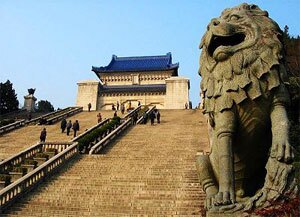 The Mausoleum is for Sun Yat-sen, the famous Chinese revolutionary hero has an area of over 80,000 sq meters. It is made up of the Memorial Archway, Tomb Passage, Mausoleum Gate, Stone Steps, Stele Pavilion, Sacrifice Hall and Coffin Chamber. The complex resembles an alarm bell. Walking through the mausoleum provides an insight into the history of Republican Period and the life story of Sun Yat-sen. Allow 2-3 hours for a complete visit.
The Mausoleum is for Sun Yat-sen, the famous Chinese revolutionary hero has an area of over 80,000 sq meters. It is made up of the Memorial Archway, Tomb Passage, Mausoleum Gate, Stone Steps, Stele Pavilion, Sacrifice Hall and Coffin Chamber. The complex resembles an alarm bell. Walking through the mausoleum provides an insight into the history of Republican Period and the life story of Sun Yat-sen. Allow 2-3 hours for a complete visit.
There is a bandstand called Zhongshanling Bandstand for Su Yat-sen. On sunny days it is a pleasant place to walk.
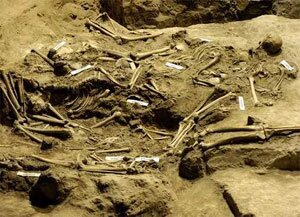 Nanjing, once the capital China, has several historical sites that should not be missed. The Memorial to the Nanjing Massacre is one of them. It’s built for commemorate the victims by Nanjing People’ Government in 1985, which contains the relics and burial place of the Nanjing massacre victims.
Nanjing, once the capital China, has several historical sites that should not be missed. The Memorial to the Nanjing Massacre is one of them. It’s built for commemorate the victims by Nanjing People’ Government in 1985, which contains the relics and burial place of the Nanjing massacre victims.
This memorial occupies a huge site and includes a large public park. It is divided into 3 parts: Squares Display, Osseous Remains Display and Historic Material Display. There are lots of photos and historical information telling a graphic story of the tragic events that occurred there and some of the politics which bought it about.
The Memorial is built on the site of one of the burial grounds from the time. It tries to provide a relatively balanced view by adding interviews and statements of some Japanese soldiers and officers who were present as well as some photos and victims’ statements.
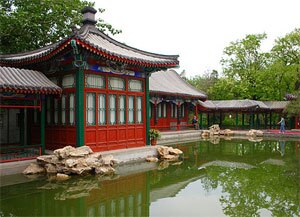 Xuan Wu Park is like an Oasis in the bustle and hustle of the city. Once an imperial garden, now the park is open to the people to enjoy the lake and the city wall. Lovely stands of trees and interesting statues offers a quiet feeling and make people feel relaxing. There are refreshment stalls and lots of docks to rent a boat. Spend 2-3 hours for a relaxing afternoon.
Xuan Wu Park is like an Oasis in the bustle and hustle of the city. Once an imperial garden, now the park is open to the people to enjoy the lake and the city wall. Lovely stands of trees and interesting statues offers a quiet feeling and make people feel relaxing. There are refreshment stalls and lots of docks to rent a boat. Spend 2-3 hours for a relaxing afternoon.
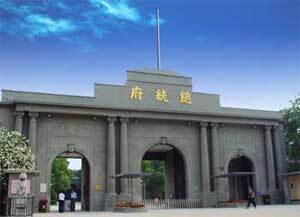 With a history of over 600 years, Nanjing has witnessed many of the most significant events in Chinese history including the rise and decline of the first Republic of China. No wonder it has largest museum highlighting modern Chinese history in the country.
With a history of over 600 years, Nanjing has witnessed many of the most significant events in Chinese history including the rise and decline of the first Republic of China. No wonder it has largest museum highlighting modern Chinese history in the country.
Covering with an area of 90,000 sq meters, it is divided into 3 parts. The middle district was used for various government departments’ handling official affairs, the west district was the office of Sun Yat-sen and Secretary’s Office, and the east district was once the former site of the executive office and the leisure area.
If you are interested in Chinese and Nanjing history, this visit would be more worthy stop.
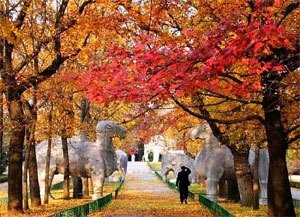 The tomb for Zhu Yuan Zhang, the first emperor and his empress during the Ming Dynasty, is the biggest imperial mausoleum in Nanjing and one of the biggest in China. In 2003 it was listed as World Cultural Heritage site.
The tomb for Zhu Yuan Zhang, the first emperor and his empress during the Ming Dynasty, is the biggest imperial mausoleum in Nanjing and one of the biggest in China. In 2003 it was listed as World Cultural Heritage site.
It covers a long walk and climb up a wall to visit the tomb. The view is beautiful, and for those who are interested in Chinese history, it has much to appreciate.
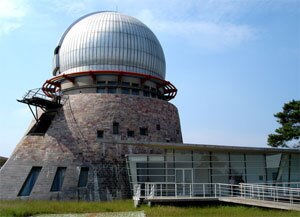 The mountain is a pretty natural hill with 3 interesting attractions. It is an important site but can be crowded. It will give you an insight into Chinese culture and history. The view from the pagoda is worth the climb. Pay Observation Deck costs 15 Yuan/person.
The mountain is a pretty natural hill with 3 interesting attractions. It is an important site but can be crowded. It will give you an insight into Chinese culture and history. The view from the pagoda is worth the climb. Pay Observation Deck costs 15 Yuan/person.
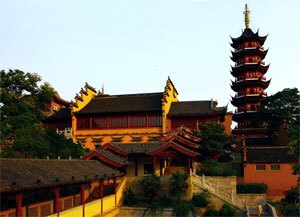 Almost every city visit in China would include with a temple tour, which shows the Chinese culture to some extent. Nanjing is no exception with Jiming Temple. This is a tranquil temple with only nuns living at the temple.
Almost every city visit in China would include with a temple tour, which shows the Chinese culture to some extent. Nanjing is no exception with Jiming Temple. This is a tranquil temple with only nuns living at the temple.
The temple is located on a small hill south of Xuanwu Park. The top of the temple offers a lovely view of the city wall, Xuan Wu Lake and the downtown area. If you want a better view from the top of the pagoda, pay extra fee. The temple is also a place to appreciate the Cherry blossom during the spring time.
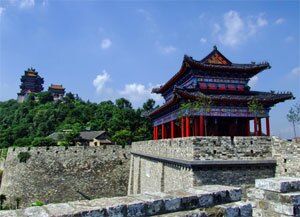 Nanjing Ming City Wall is the longest city wall in the world at 35.5 km. The second longest is the Paris City Wall at 29.5 km. With a history of over 600 years and built by Zhu Yuanzhang, the first Ming emperor, the city wall is truly splendid and one of the best preserved in China.
Nanjing Ming City Wall is the longest city wall in the world at 35.5 km. The second longest is the Paris City Wall at 29.5 km. With a history of over 600 years and built by Zhu Yuanzhang, the first Ming emperor, the city wall is truly splendid and one of the best preserved in China.
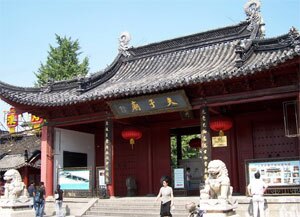 The Temple is built in Ming and Qing architectural style and has China’s biggest bronze statue of Confucius at 4.18 meters high and weighing 2,500 kg. It was built during 1034 and rebuilt in 1869. It was destroyed during the Second World War. After the liberation of China, the Nanjing government rebuilt it and made it a landmark site along the Qinhuai River
The Temple is built in Ming and Qing architectural style and has China’s biggest bronze statue of Confucius at 4.18 meters high and weighing 2,500 kg. It was built during 1034 and rebuilt in 1869. It was destroyed during the Second World War. After the liberation of China, the Nanjing government rebuilt it and made it a landmark site along the Qinhuai River
The area around Confucian Temple has become one of busiest areas in Nanjing and has many food options and souvenir to remember your visit. At night the view is brilliant and it’s also a good part of town to eat your way around. If you want to take something back home, the area offers a lot to choose. Just remember to bargain.
 Connecting the downtown area and Pukou district, Nanjing Yangtze River Bridge was the first double deck bridge for railway and road traffic in China. The upper deck is the road bridge at 4589 meters long and 15 meters wide while the lower deck is the railway bridge at 6772 meters long and 14 meters wide. The Main Bridge is 1577 meters long with the rest being the approaches. With 200 statues and 150 pairs of magnolia flower-shaped street lamps, the bridge is an attraction in its own right.
Connecting the downtown area and Pukou district, Nanjing Yangtze River Bridge was the first double deck bridge for railway and road traffic in China. The upper deck is the road bridge at 4589 meters long and 15 meters wide while the lower deck is the railway bridge at 6772 meters long and 14 meters wide. The Main Bridge is 1577 meters long with the rest being the approaches. With 200 statues and 150 pairs of magnolia flower-shaped street lamps, the bridge is an attraction in its own right.
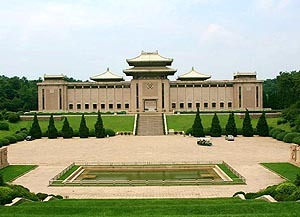 Located 1 km from Zhonghua Gate, Yu Hua Tai Interest Spot is a historical place with beautiful scenery. It consists of six areas - Scenic Spot and Historic Resort, The Martyrs Cemetery Area, Cultural Area of Yu Hua Stone, Cultural Area of Yu Hua Tea, Recreational Area and the Ecological Forest Area.
Located 1 km from Zhonghua Gate, Yu Hua Tai Interest Spot is a historical place with beautiful scenery. It consists of six areas - Scenic Spot and Historic Resort, The Martyrs Cemetery Area, Cultural Area of Yu Hua Stone, Cultural Area of Yu Hua Tea, Recreational Area and the Ecological Forest Area.
It commemorates Chinese revolutionary predecessors and also it offers beautiful scenery to see. Around the station there is a small market which sells local specialties.
There is once a beautiful story about the name. A Buddhist monk once spoke to a crowd there and his words were so pious that they touched heaven, flowers fell from heaven like raindrops (Yu Hua). The colorful stones in water are called Yu Hua Shi, which means raindrop flowers.
Yu Hua Stones are easy to find everywhere in Nanjing, but they don’t compare with those of Yu Hua Tai.
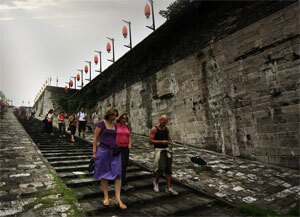 Zhonghua Gate is the largest ancient castle in China. The structure was the south gate of the capital during the early Ming Dynasty and was named Jubao Gate later. In 1931, the name was chaged to Zhonghua Gate. The castle was builtas fortification in ancient times. The gate is both massive in size and in human accomplishment and reflects the role of Nanjing as imperial center of government and power. The view of the wall and surrounding the city is amazing from he top. It is possible to bike along the wall.
Zhonghua Gate is the largest ancient castle in China. The structure was the south gate of the capital during the early Ming Dynasty and was named Jubao Gate later. In 1931, the name was chaged to Zhonghua Gate. The castle was builtas fortification in ancient times. The gate is both massive in size and in human accomplishment and reflects the role of Nanjing as imperial center of government and power. The view of the wall and surrounding the city is amazing from he top. It is possible to bike along the wall.
 Qinhuai River is the mother river for the city. The river crosses the downtown area from east to west and meets Yangtze River at Xishui Pass.
Qinhuai River is the mother river for the city. The river crosses the downtown area from east to west and meets Yangtze River at Xishui Pass.
The river can tell many stories. Its heyday was during the Ming and Qing Dynasties. However the effect of wars and the decline of river transport decreased its economic importance. In 1985, Nanjing government restored the river and surrounding area to make to its former beauty.
The lantern display on a boat rise at night is beautiful. The busiest period is at Spring Festival when a lantern show is staged. Usually an outing to the Qinhuai River would be combined with a walk around the local market along the bank. If you want to buy remember bargain hard!
 Nanjing Underwater World could be a haven from the summer heat and very interesting for children. Around 200 species and more 10,000 ocean creatures live at the aquarium. It the main hall, the computer classroom, corridor, tropical rain forest district, penguin hall, seal performance hall, sub-bottom tunnel, underwater cinema, the petting section and theater to see the dancing with sharks show.
Nanjing Underwater World could be a haven from the summer heat and very interesting for children. Around 200 species and more 10,000 ocean creatures live at the aquarium. It the main hall, the computer classroom, corridor, tropical rain forest district, penguin hall, seal performance hall, sub-bottom tunnel, underwater cinema, the petting section and theater to see the dancing with sharks show.